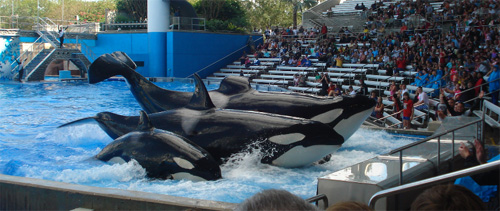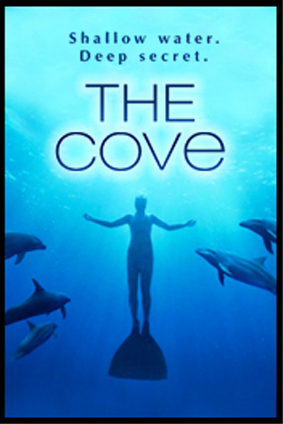The Drive Hunts
Capturing a few and killing the rest
The Big Business of DolphinsPart 2 of “Dolphins & Us“ The Business of Dolphins The Movie that Launched a Revolution The Real Story: Freeing Keiko Ric O’Barry: From Flipper to The Cove Tilikum: The Slave Who Fought Back Life and Death at SeaWorld The Drive Hunts Interviews & Reports “Don’t Buy a Ticket!” More about Ric O’Barry The “Spartacus” of Whales My Visit to SeaWorld A Whale of a Business The Cove NEXT: Part Three: Saving the Dolphins. See also Part One: The Smartest of Us All? |

In the United States, there’s a moratorium on capturing dolphins in the ocean and bringing them to a theme park. So they’re either bred in captivity or they’re traded for other dolphins at theme parks around the world.
But as part of the big business of dolphins, SeaWorld and the other amusement parks remain intimately involved with the capture and killing industry that’s portrayed so vividly in the movie The Cove. It’s an industry that’s basically left to regulate itself through a shady collection of international trade associations that form a good-ole-boy network that resists any efforts to bring about change.
Ric O’Barry, who gave up his career as a dolphin trainer 40 years ago, knows the industry inside out. And the trade associations avoid him like the plague.
“I’ve been trying for years to get the Association of Zoos and Aquariums involved in the dolphin drive hunts in Taiji,” he told us. “But they won’t even go to Taiji.” (That’s where one of the most infamous drive hunts takes place). “If you’ve seen The Cove, you can see about 30 dolphin trainers standing there right next to the people who are killing them. They have a symbiotic relationship. They don’t do anything to stop the dolphin slaughter. It’s an industry of hypocrites.”
The hidden world of undercover trading
In 1997, the PBS program Frontline aired a special investigation, “A Whale of a Business”, that focused on the captive dolphin industry. Part of the show is about the nefarious transactions by which big companies move whales and dolphins around the world and hide the incriminating documents. Frontline interviews several officials and veterinarians from SeaWorld about a particular dolphin transaction that involves SeaWorld and two entertainment parks in Japan and Holland. Each of the officials denies knowing anything about it. But Frontline then produces the documents that reveal that they were, in fact, all in Japan together, all working on the deal. It’s just one example of what goes on in this sordid business. (You can read the transcript of the interview here.)
 And if you haven’t seen the Oscar-winning movie The Cove, you should see it. It’s a documentary that plays more like a thriller, as Ric O’Barry and a Mission Impossible-like team sneak into the small town of Taiji, Japan, with crates of high-tech equipment so they can film one of the dolphin massacres without being seen. Taiji is a town right out of a Stephen King horror movie – one of those places where everything looks normal on the surface, but where visitors are kept away (kidnapped and even, yes, murdered if necessary) so they can’t see or tell other people about the dark secret of the dolphin massacres that go on there.
And if you haven’t seen the Oscar-winning movie The Cove, you should see it. It’s a documentary that plays more like a thriller, as Ric O’Barry and a Mission Impossible-like team sneak into the small town of Taiji, Japan, with crates of high-tech equipment so they can film one of the dolphin massacres without being seen. Taiji is a town right out of a Stephen King horror movie – one of those places where everything looks normal on the surface, but where visitors are kept away (kidnapped and even, yes, murdered if necessary) so they can’t see or tell other people about the dark secret of the dolphin massacres that go on there.
As a follow-up to The Cove, Ric O’Barry’s son, Lincoln, has a TV series, Blood Dolphins, on Animal Planet, that’s a follow-up to The Cove.
The captivity industry is fighting back for all it’s worth, but the pressure is now seriously building to bring an end to the slaughter and exploitation of dolphins for profit.
In the next section of this feature, we look at how scientists, attorneys, Congress people, movie makers, animal protection groups, and thousands of us at the grassroots are coming together in a remarkable new campaign.
